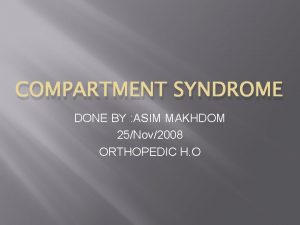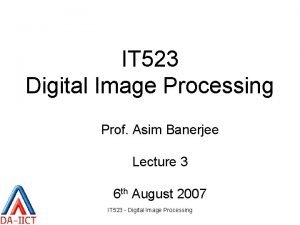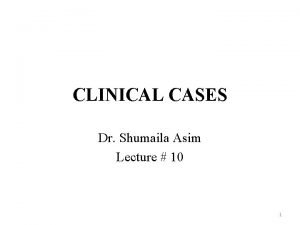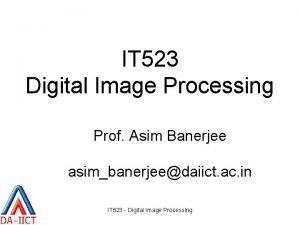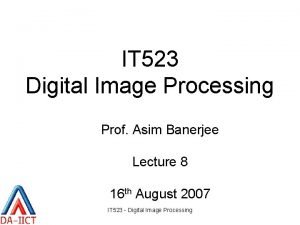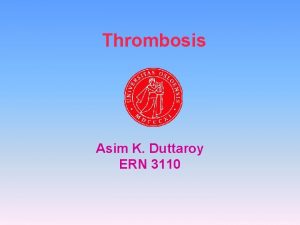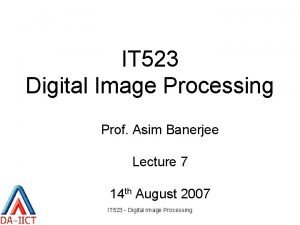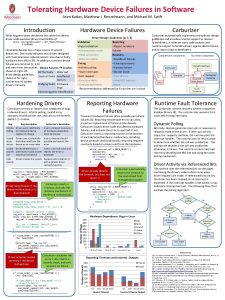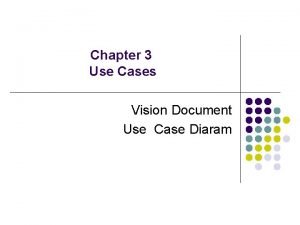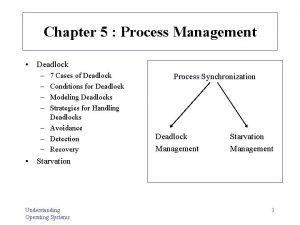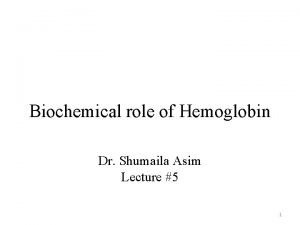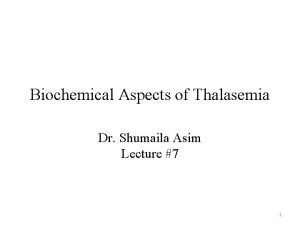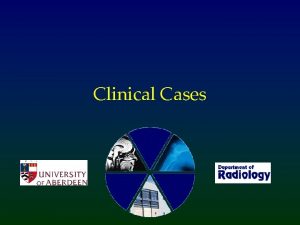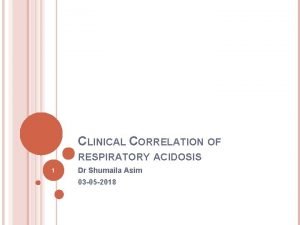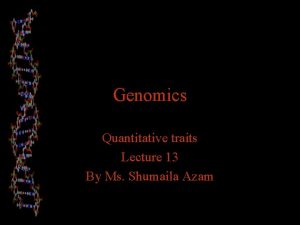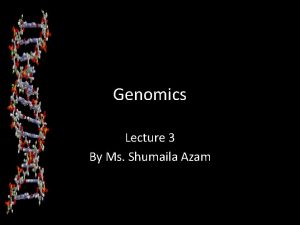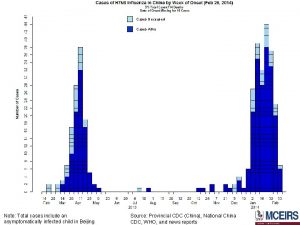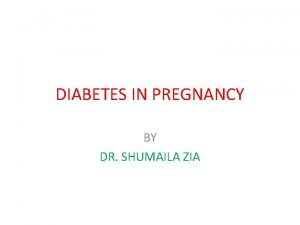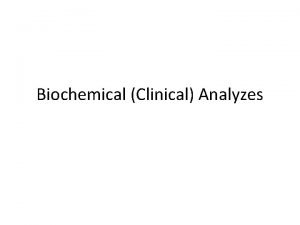CLINICAL CASES Dr Shumaila Asim Lecture 10 1




























- Slides: 28

CLINICAL CASES Dr. Shumaila Asim Lecture # 10 1

PORPHYRIA CASE • A 30 -year-old woman had severe abdominal pain, nausea, vomiting and diarrhea. Evaluations including endoscopies did not establish any intestinal infection. She gradually improved and was discharged after 2 weeks. 2 years later she was admitted to a psychiatric unit with acute mental changes and hallucinations, she had to be transferred to the emergency department due to abdominal pain, a grand mal seizure and hyponatremia. • She was disoriented but had no focal neurological signs. Gradually she progressed to quadriparesis, respiratory failure and aspiration pneumonia. Urinary porphobilinogen (PBG) was reported as 44 mg/24 hours (reference range 0 -4). • What is the diagnosis and defect in this disease? • Why urinary porphyrinogen level is increased? • What is the genetic basis of this disease? 2

• The patient is suffering from acute intermittent Porphyria as evident from the typical combination of abdominal pain, motor neuropathy, psychiatric symptoms and increased amounts of urinary Porphyrins and their precursors. The disorder is caused by partial deficiency of porphobilinogen deaminase activity • The Porphyrias are a group of rare metabolic disorders arising from reduced activity of any of the enzymes in the heme biosynthetic pathway. • The disorders may be either acquired or inherited through a genetic defect in a gene encoding these enzymes. • These deficiencies disrupt normal heme production, and produce symptoms when increased heme is required. Porphyrin precursors, overproduced in response to synthetic pathway blockages, accumulate in the body and cause diverse pathologic changes thereby becoming the basis for diagnostic tests. • The diagnosis of acute porphyrias can be confirmed by repeating the quantitation of urinary porphyrin during an acute episode and finding elevated levels (2– 5 times of normal) of porphobilinogen. 3

Acute intermittent porphyria A 24 - year- old patient was brought to medical OPD with acute abdominal pain, depression and Extreme weakness. Urine analysis revealed the presence of ALA and PBG (Delta amino Levulinic acid and Porphobilinogen). The patient was diagnosed with acute intermittent porphyria, which of the following enzyme deficiencies is expected in this patient? a) Uroporphyrinogen III cosynthase b) Uroporphyrinogen decarboxylase c) Porphobilinogen deaminase d)ALA Dehydratase 4

5

6

Congenital Erythropoietic porphyria Porphyrins are deposited in teeth and in bones, as a result, the teeth are reddish-brown and Fluoresce On exposure to long-wave ultraviolet light, so called ‘Erythrodontia’, is a sign of which porphyria ? a) Variegate porphyria b) Acute intermittent porphyria c) Congenital Erythropoietic porphyria d) Hereditary Coproporphyria 7

8

Congenital Erythropoietic porphyria It is also known as Günther disease, is an autosomal recessive disorder. It is due to the Markedly deficient, but not absent, activity of Uroporphyrinogen III synthase and the resultant accumulation of uroporphyrin I and coproporphyrin I isomers. CEP is associated with hemolytic anemia and cutaneous lesions. Clinical Features Severe cutaneous photosensitivity begins in early infancy. The skin over Light-exposed areas is friable, and bullae and vesicles are prone to rupture and infection. Skin thickening, hypo- and hyperpigmentation, and hypertrichosis of the face and extremities are characteristic. Secondary infection of the cutaneous lesions can lead to disfigurement Of the Face and hands. Porphyrins are deposited in teeth and in bones. As a result, the teeth are reddishbrown and fluoresce on exposure to long-wave Ultraviolet light. Erythrodontia)-Hemolysis is probably due to the marked increase in Erythrocyte porphyrins and leads to splenomegaly. Diagnosis Uroporphyrin and coproporphyrin (mostly type I isomers) accumulate in the bone marrow, erythrocytes, plasma, urine, and feces. The disease can be detected in utero by measuring porphyrins in amniotic fluid and URO-synthase activity in cultured amniotic cells or chorionic villi, or by the detection of the family’s specific gene mutations. 9

10

Porphyria cutanea tarda An 8 year old boy was brought to a dermatologist as he had developed vesicles and bullae on his face and arms that appeared after a week long football practice in sun. His father had a similar condition. A diagnosis of Porphyria cutanea tarda was confirmed by finding elevated levels of porphyrins in his serum. His disease is due to a deficiency of which of the following enzymes? a) ALA dehydratase b) Ferrochelatase c) PBG deaminase d) Uroporphyrinogen decarboxylase. 11

12

13

Viral hepatitis A patient presents with dull right sided abdominal pain, fever from the 7 days, loss of appetite, pale stool and jaundice. Blood biochemistry reveals, mixed hyperbilirubinemia, high ALT but near normal alkaline phosphatase levels. What is the cause of jaundice? a) Viral hepatitis b) Post hepatic jaundice c) Hemolytic jaundice d) Drug induced jaundice 14

Carcinoma of head of the pancreas A 65 - year –old patient presents with weight loss, loss of appetite, dull dragging pain in the Right hypochondrium and jaundice from the last 1 month. Stool is reported to be clay colored from the same duration. Blood biochemistry reveals Conjugated hyperbilirubinemia. Urine shows the presence of bilirubin. The patient has been diagnosed with carcinoma of head of the pancreas. Which serum enzyme is expected to be much higher than normal for this patient? a) ALT (Alanine amino transferase) b) AST (Aspartate amino transferase) c) LDH (Lactate dehydrogenase) d) ALP (Alkaline phosphatase). 15

16

17

G-6 -P-D deficiency case • A 10 –year- old boy received a sulfonamide antibiotic as prophylaxis for recurrent urinary tract infections. Although he was previously healthy and well nourished, he became progressively ill and presented with pallor and irritability. A blood count revealed that he was severely anaemic with jaundice due to hemolysis of the red blood cells. • What is the problem with the boy? • What is the cause of anemia and jaundice in this boy? • What is the simplest way for the diagnosis of this problem? 18

• Case details The child is suffering from Glucose-6 phosphate dehydrogenase deficiency. The individuals with G -6 -P-D deficiency present with excessive hemolysis on exposure to certain drugs like antibiotics, analgesics and Antimalarials. • Acute hemolytic anemia can develop as a result of three types of triggers: (1) fava beans, (2) infections, and (3) drugs. • Glucose 6 -phosphate dehydrogenase (G 6 PD) is an enzyme critical in the redox metabolism of all aerobic cells. • In red cells, its role is even more critical because it is the only source of reduced nicotinamide adenine dinucleotide phosphate (NADPH), which, directly and via reduced glutathione (GSH), defends these cells against oxidative stress. 19

20

21

• NADPH is a required cofactor in many biosynthetic reactions which also maintains glutathione in its reduced form. Reduced glutathione acts as a scavenger for dangerous oxidative metabolites in the cell. • With the help of the enzyme glutathione peroxidase, reduced glutathione converts harmful hydrogen peroxide to water. The inability to decompose hydrogen peroxide results in free radical induced membrane disruption and reduced life span as a result of haemoglobin formation. • G 6 PD deficiency is a prime example of a haemolytic anemia due to interaction between an intracorpuscular and an extracorpuscular cause, because in the majority of cases hemolysis is triggered by an exogenous agent. • People deficient in glucose-6 -phosphate dehydrogenase (G 6 PD) are not prescribed oxidative drugs, because their red blood cells undergo rapid hemolysis under this stress. • Although in G 6 PD-deficient subjects there is a decrease in G 6 PD activity in most tissues, this is less marked than in red cells, and it does not seem to produce symptoms. 22

23

• Clinical manifestations The vast majority of people with G 6 PD deficiency remain clinically asymptomatic throughout their lifetime. • However, all of them have an increased risk of developing neonatal jaundice (NNJ) and a risk of developing acute hemolytic anemia when challenged by a number of oxidative agents. • Typically, a haemolytic attack starts with malaise, weakness, and abdominal or lumbar pain. After an interval of several hours to 2– 3 days, the patient develops jaundice and often dark urine, due to hemoglobinuria. The onset can be extremely abrupt, especially with favism in children. • The anemia is moderate to extremely severe, usually Normocytic and Normochromic, and due partly to intravascular hemolysis; hence, it is associated with haemoglobinemia, hemoglobinuria, and low or absent plasma Haptoglobin. Jaundice is prehepatic. 24

• Treatment- Identification and discontinuation of the precipitating agent is critical in cases of glucose-6 phosphate dehydrogenase (G 6 PD) deficiency. • Affected individuals are treated with oxygen and bed rest, which may afford symptomatic relief. • Prevention of drug-induced hemolysis is possible in most cases by choosing alternative drugs. When acute HA develops and once its cause is recognized, no specific treatment is needed in most cases. • However, if the anemia is severe, it may be a medical emergency, especially in children, requiring immediate action, including blood transfusion. 25

Abnormal liver function tests A 28 -year-old man with a long history of intravenous drug abuse and chronic hepatitis B presented with jaundice. Physical Examination revealed an anemic, malnourished man with dependent pitting edema and ascites. He had the following Profile Total protein 8. 2 g. /d. L , Albumin 2. 6 g/dl , Globulins 5. 6 g/d. L, Total Bilirubin 6. 0 mg/d. L , AST 200 U/L , ALT 350 U/L , ALP (Alkaline Phosphatase) 180 U/L, CBC: macrocytic anemia with hyper segmented neutrophils, mild neutropenia, and mild thrombocytopenia, Prothrombin time (PT) was prolonged and Urinalysis: Positive for Bilirubin i)What is the clinical significance of his abnormal liver function tests, hypoalbuminemia, and prolonged prothrombin time that does not correct with intramuscular vitamin K? ii) What is the most likely cause of the macrocytic anemia? 26

Cause for Abnormal liver function tests The patient is most probably suffering from chronic endstage liver disease secondary, most likely, to chronic hepatitis B. 1) Transaminases The transaminases are moderately elevated, and ALT is higher than AST. In acute hepatitis, the transaminases would be higher owing to the presence of more liver tissue; however, in chronic hepatitis, the loss of hepatocytes and replacement by fibrosis results in less of an increase. 27

28
 Criminal cases vs civil cases
Criminal cases vs civil cases 01:640:244 lecture notes - lecture 15: plat, idah, farad
01:640:244 lecture notes - lecture 15: plat, idah, farad Asim makhdom
Asim makhdom Asim banerjee
Asim banerjee Asim banerjee images
Asim banerjee images Asim siddiqui azim premji university
Asim siddiqui azim premji university Dr asim lectures
Dr asim lectures Asim banerjee images
Asim banerjee images Asim kadav
Asim kadav Asim kadav
Asim kadav Asim banerjee images
Asim banerjee images Plaetelet
Plaetelet Anjum asim shahid rahman
Anjum asim shahid rahman Asim banerjee images
Asim banerjee images Asim software
Asim software Global marketing contemporary theory practice and cases
Global marketing contemporary theory practice and cases Electrical engineering ethics
Electrical engineering ethics Service chaining use cases
Service chaining use cases Managerial economics: theory, applications, and cases
Managerial economics: theory, applications, and cases Sign convention for spherical mirror
Sign convention for spherical mirror Cases
Cases Writing effective use cases by alistair cockburn
Writing effective use cases by alistair cockburn Supreme court cases graphic organizer answers
Supreme court cases graphic organizer answers Sexual harassment cases in correctional centres
Sexual harassment cases in correctional centres System vision document
System vision document 7 cases of deadlock in operating system
7 cases of deadlock in operating system Ra 9344 cases
Ra 9344 cases Important court cases apush
Important court cases apush Sharecropping
Sharecropping


